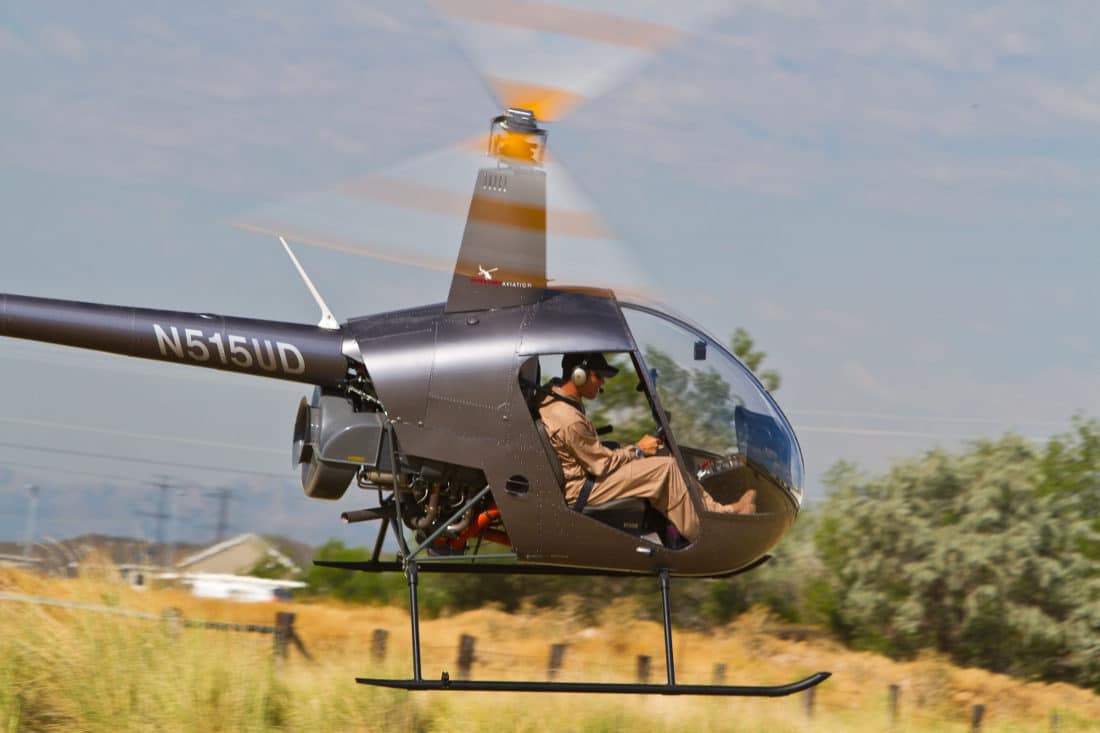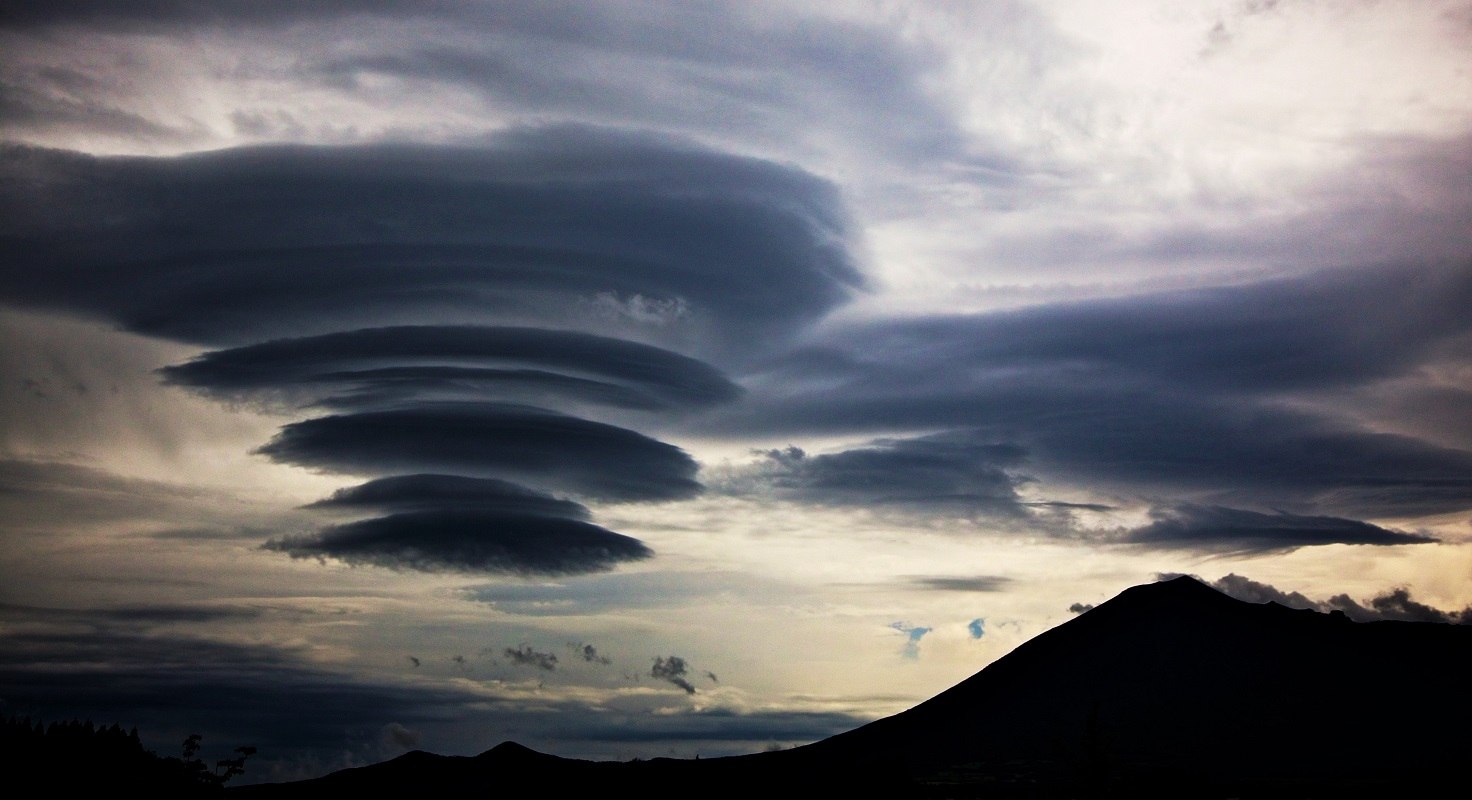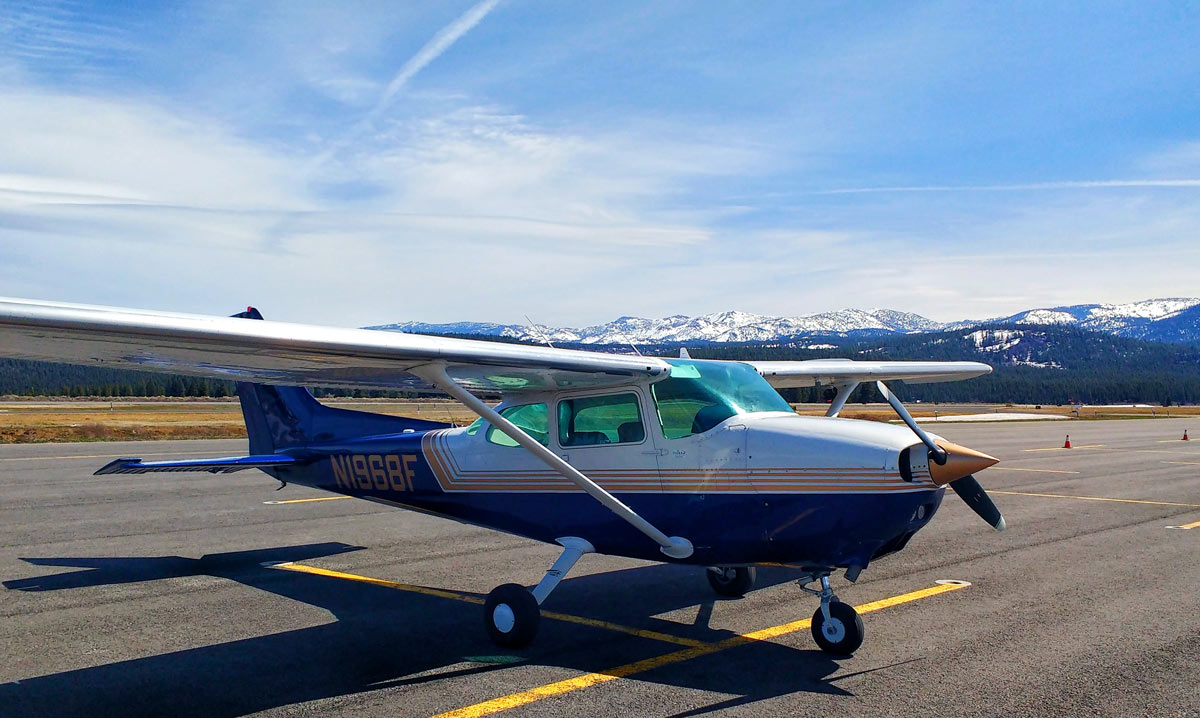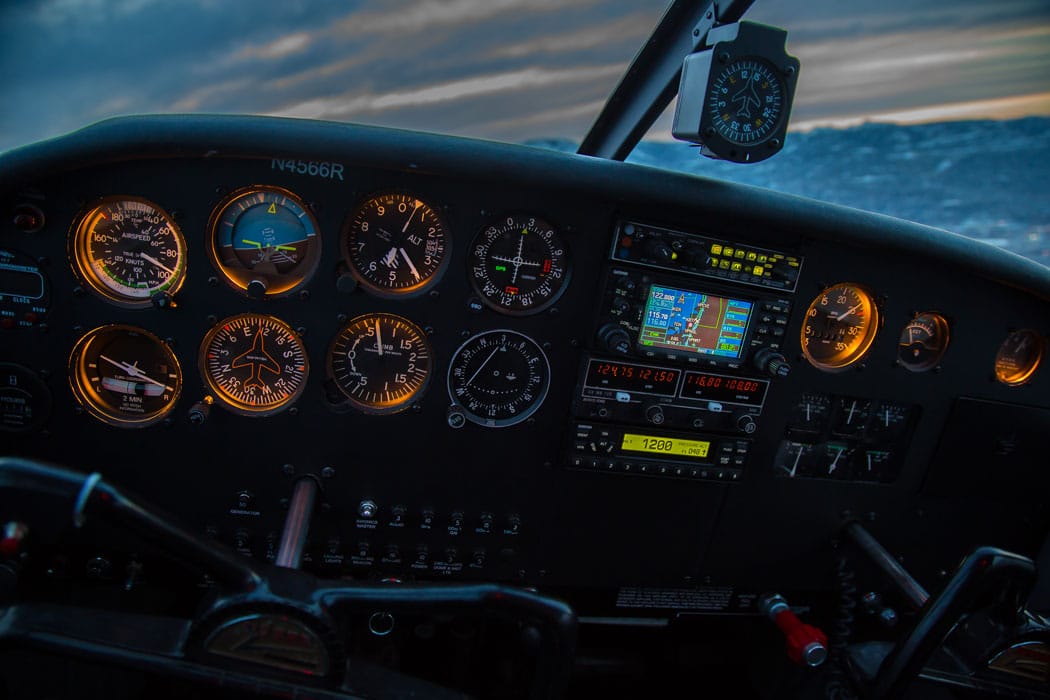Over the Mountains and Through the Wind; To Reno-Stead Airport We Go!
[This is the 13th in a series of articles detailing my journey to earning a private pilot certificate. Click to read: Part 1, Part 2, Part 3, Part 4, Part 5, Part 6, Part 7, Part 8, Part 9, Part 10, Part 11, Part 12.]
Last week, I had a ground school lesson and experienced the joys of sectionals and E6B’s. It reminded me of being in high school geometry. It wasn’t exciting. However, the next day, I was supposed to fly to Reno-Stead Airport and do some touch-and-go’s with Dave, my instructor, and I was in charge of the whole shebang. I was stressing out about some life stuff but figured flying would clear my head. I called 1-800-WXBRIEF for the first time, got the runway information, and got to the airport nearly 45 minutes early so I could call AWOS and maybe even try and set the course on the iPad.
Weather Briefing En-Route to Reno-Stead Airport is Not Looking Good
The weather briefer didn’t have anything good to say: VFR not recommended, mountain obscuration, high winds and convective currents over the ridgeline with crazy gusts, and the clouds were supposed to clear, but not until a couple hours after we’d return. I figured Dave and I would go over the weather and end up doing ground school instead of trying to go flying in turbulence over the Sierra Nevada Mountains to Reno-Stead Airport (about 24nm Northeast of Truckee-Tahoe Airport), but I pre-flighted the plane anyway.
By this point, Truckee was experiencing 15-knot winds, gusting 25, straight down runway 20. Dave and I discussed the weather, and he said that all that was just part of mountain flying, so we pulled the plane, a blue and gold Skyhawk, out and hopped in. I was flustered by the weather and didn’t have my head in the right place, and getting rocked around in the eddies of gusting wind swirling between the two rows of hangars made me a bit uncomfortable. Dave noticed I wasn’t really present in the cockpit, and after a short chat, he called off the flight. I felt so pathetic, wasting the opportunity to fly because I can’t get out of my head.
Once some time had passed, I realized that I was relieved not to fly in “moderate turbulence” over a mountain ridge, but a week has passed and I still haven’t been able to shake that feeling of disappointment. I dedicated myself to studying and memorizing everything I could so that I would feel prepared for my next lesson and hopefully regain some of the confidence I lost.
Reno-Stead Airport and Flying in Turbulence: Round Two
My next lesson was at 12 PM, and since the weather was good (other than the inescapable turbulence we get here in the afternoon), I figured we’d be headed for Stead. I called the weather briefers and took notes on Reno-Stead Airports CTAF, AWOS, and traffic patterns, and was feeling pretty good about things!

When I pulled up to Sierra Aero, I noticed the Skyhawk, 68F, parked out on the tarmac. I headed for it and Dave caught me, telling me to taxi over and fill ‘er up, and that he’d meet me over there. Sweet, another couple minutes as pilot-in-command! I did the pre-flight, hopped in the cockpit, requested a radio check, and announced I’d be taxiing to the fuel island. It was really pretty outside, but following the yellow line to the fuel island put me at the mercy of a direct gusting crosswind. So, when I say “following the yellow line,” I mean it fairly loosely.
Regardless, I made it there safely, shut ‘er down, filled ‘er up and waited for Dave. While I was parked there, an older gentleman pulled up in a gorgeous blue and yellow plane that I think was a Vans RV-8. One of these days, I thought to myself, I’m going to fly a plane like that.
Dave and I met up, had a quick pre-flight chat regarding the plan, and hopped in the cockpit, taxiing over to runway 20 for north departure, which means “a left 270, fly overhead the field to the sewage plant, and then on course.” Just to make sure, I told Dave my intentions with a question mark at the end, inviting him to correct me if I was wrong. He remained quiet, so after completing the run-up and getting us on the center line, I put in full throttle and away we went!
Ascents and Updrafts
The wind immediately made itself known, and to get over the ridge to avoid the downdraft on the other side (we had a tailwind, which would mean an updraft on our side of the mountain and a downdraft on the other), I had to gain a ton of altitude. My plan was to get to 9,500, but the turbulence was making it difficult to maintain a solid climb. As we neared the mountain, overflying Stampede Reservoir– which has melted completely since I saw it last- Dave told me I could “cheat” by flying over the mountains to use the updraft to gain altitude. It took some finagling, but eventually, we got up to the target altitude, just as I turned to fly through the saddle into the Reno area.
Dave directed me to fly to the left of the “dried-up lakebed” which is actually flooded at the moment, due to the snow melt and recent rainstorms, and head toward the airport. Dave quickly brought my attention to our altitude: still 9,500ish, and the TPA for Reno-Stead Airport is only 5,800 or so. I had to lose nearly 4,000 feet, and I could see the airfield already.
Entering the Pattern at Reno-Stead Airport
I joined the pattern for runway 26 on the 45, still trying to lose altitude, and consequently, the extra airspeed that came with a rapid descent. However, by the time I was turning final, I somehow ended up too slow. I glanced out to the left window, where a giant murky lake had swallowed half of a small town, many houses and yards completely flooded, with a few surrounded by homemade walls which kept them safe. I let myself get distracted thinking about this, and with the winds and all that, it made for a sloppy and frightening approach. I felt like I was riding a bull that desperately wanted to throw me off, veering right and left and hopping and crouching, anything to get me to lose control. I kept telling Dave, “I don’t like this, I don’t like this…” among many other unprintable phrases and decided to go around.
Freaked out as I was, I mixed up the touch-and-go procedure with the go-around procedure and flipped off all the flaps at once. We immediately sunk, despite me jamming in the throttle, and Dave had to intervene by putting two notches of flaps back on before I even knew what had happened. I felt foolish.
Dave took the controls, and did a demonstration lap around the pattern, narrating as he went. Luckily, no one else was flying that day, so we had time and space to mess around. When Dave turned final, I noticed the wind was still harassing him. He said he’d only go with 20 degrees of flaps and came in a little hot to push through the turbulence, and it was a good landing.
He handed me back the controls, and we exited the area, climbing to 8,500 and heading toward the pass we flew through on the way in. We discussed all the ways my landing went wrong (too slow, too high, when I tried to correct I did the wrong things, and that I really need to memorize all of the appropriate procedures), and got hit by the turbulence, which was almost as fun.
 Robinson R22 Helicopter: All About Economy of Operation
Robinson R22 Helicopter: All About Economy of Operation
In the early 1970s, Frank Robinson had a vision of business executives commuting between their homes and workplaces in small, light, affordable helicopters. The skies were going to be filled with these little two-person helicopters, giving people freedom they’ve never had. This helicopter was going to be all about economy of operation. He designed the two-bladed helicopter, which would become the R22 [Read More]
Back to Truckee-Tahoe Airport
We flew back to Truckee with no incidents, and Dave and I chatted about the fastest planes he’s ever flown (a Pilatus), and the whole “rotorcraft thing.” A good friend of mine doesn’t have any interest in fixed wing, but her dream is to fly helicopter tours in Hawaii, so I asked Dave about the process. He said that learning to fly rotorcraft can be twice as expensive as fixed wing, and takes a lot longer. Yikes.
Anyway, we listened to the weather and decided runway 20 would still be the best option, so I entered the extended right base over the agricultural station by the freeway, and realized I was too high again! I pulled the power back and adjusted the pitch, and when I turned right for final, the wind pushed me around and I got really nervous. I know this would really never happen, but it’s hard to make yourself bank sharply when it feels like the wind could just roll us over. On approach, I somehow ended up too low (the VASI was giving me all red), so I added a little power. Dave said, “Put in all the power,” so I did, and we climbed just in time to be too high. I was flying something like 30 feet above the runway, wiggling around the centerline, feeling completely helpless. I pulled the power back out and pitched down, then got nervous and leveled out too high over the runway (15ft). Dave said, “No, keep going, keep going,” over my steady stream of cursing, so I pitched back down, and tried again.
It felt like forever, but eventually, we got down and I landed hard on the right gear, which bounced us around and made me let out a little “Eek!”
“That was not good,” I said to Dave, sweating. Dave replied, “It was a learning experience,” to which I responded, “That’s not what I would call it.”
“Then what would you call it?”
“A total $#!%-show.”
Advice on Landings and Controlling the Airplane
He laughed for half a second before getting serious and saying, “It wasn’t a $#!%-show, but it wasn’t good. And when you’re coming in for a landing, cursing [he was a little more specific here, but I’ll let you use your imagination] isn’t going to do anything. Get more active with your feet and your hands. Dance on the rudder pedals, keep the yoke going; take back the control. You gotta slap the plane around.”

I laughed at that, and immediately felt bad. Poor airplane, it’s not her fault I suck at this. Because I had flown over so much of the runway, we exited and followed the taxiway back to the start instead of doing a touch-and-go. Once I got us lined up on the centerline, I put in the throttle, and we started ripping down the runway. I feel like Vr hit us much faster than I thought it would, but I guess that’s because of the considerable headwind we had. We peeled away from the ground and headed up and out over the highway, before doing our left 270 and overflying runway 29 down to the other highway, then turning to enter the extended right base. This time, altitude wasn’t a problem, but the winds were still just so aggressive. Dave calls flying in turbulence “sporty,” as in, “Yeah it’s pretty sporty today,” whenever I point out the wind dropping us and pushing us around.
Well, “sporty” is another good Dave-ism (Dave + euphemism) for the books. Next time you’re flying in turbulence and your passengers are like, “Where’s the barf bag? I feel like I’m on a roller coaster!” Just say, “Nah, it’s just sporty.” Anyway, enough of my whining.
Last Lap of the Lesson
When I turned final for runway 20, we were at the right altitude and almost the right speed. I was surprised at how well I was holding the runway and descent steady compared to the first time around. I felt like I was nailing it until we got down over the numbers, and I felt like I started fishtailing. Maybe I was dancing too much on the rudder pedals?
The landing was not good (kind of rough, and solidly on the right side of the centerline), but Dave said it was my best approach yet (“For this lesson,” he clarified).
“Yeah, I don’t know what happened,” I said dejectedly.
“You let the wind and the ground get to your head,” he said, and I knew it was true. When it’s turbulent, I have a much harder time trying to convince my body to actively point the airplane at the ground, which makes landing impossible. Touching the ground is a pretty big part of landing.
We called it for the day and taxied back to Bravo row hangars to put 68F back inside for the day. A big storm was headed our way, so all lessons for the next couple days were canceled, and the following week, Dave is taking his family to Santa Cruz for spring break, so no lessons for a while.
Final Thoughts on Flying in Turbulence to Reno-Stead Airport and Regaining My Confidence
Dave told me he had me scheduled for 2 PM lessons the week after, and my stomach dropped a little bit. Truckee in the afternoon rivals Chicago for the title of “The Windy City.” When I asked if there’s anything I could specifically work on for our next lesson, Dave told me I needed to be more confident, assertive, and allow myself to make mistakes so that I can learn. Though I felt like I made a ton of mistakes, I understand what he meant about the confidence thing. It’s hard to feel confident when you feel completely out of control behind the controls. Even when I think I know the right thing to do, I feel like I can’t do it properly because of flying in turbulence and my own mental blocks, and knowing my next two flights are going to be in bumpy, “sporty” conditions, I’m not excited to fly. Which really bums me out. For the last few months, knowing that I get to fly is what gets me up in the morning and through the week, but now I just kind of feel lost.

Mountain Wave: My Scariest Flight Ever
A moment later the plane crossed the ridge and suddenly everything went wild. The first smack knocked our headphones off and our heads into the ceiling despite seat belts. The kids in back screamed; they had secretly unbuckled their belts and were being tossed about. If you can imagine floating calmly in the ocean and suddenly being sucked over the edge [Read More]















Leave a Reply